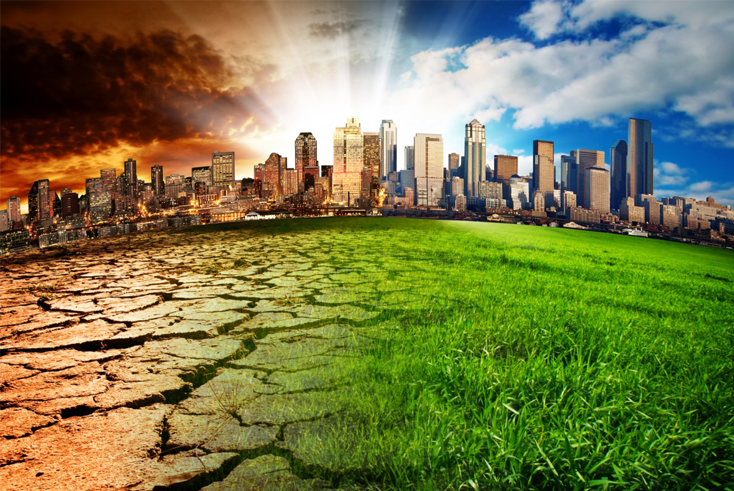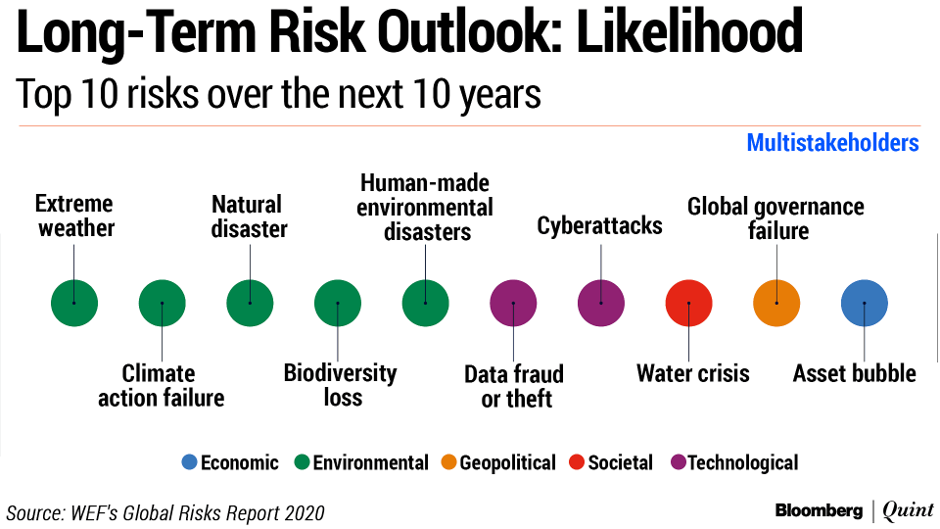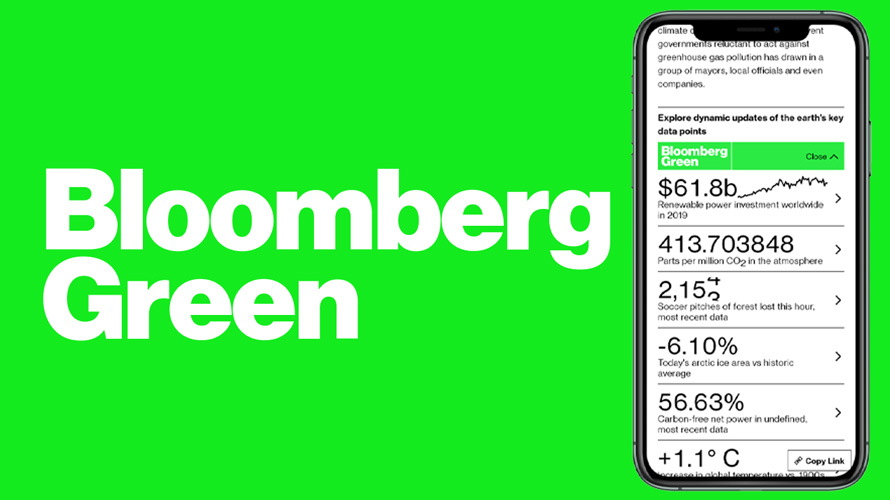Media for tomorrow’s world

Partner content
One way to combat climate apathy must be to make the crisis a part of our daily conversation, writes Bloomberg’s Arif Durrani
What will our world look like in 2050? What are today’s trends that are set to take hold and shape the next generation?
Forecasting so far into the future can feel futile; too many variables and too far into the distance to be of any discernible use. Yet designers and innovators have long known that the very act of imagining and playing with something helps to make new ideas become a reality. It’s the reason why the automotive industry spends millions of pounds on developing concept cars.
Some visions are a clear statement of intent. A chance to showcase current thinking and test reactions to new technologies. Others provide stark warnings and can provoke action.
In the UK, the BBC used to run a science programme called Tomorrow’s World dedicated to precisely this sort of future-gazing. The show ran for almost 40 years back when people only had three other TV channels to choose from. In its 1980s heyday Tomorrow’s World attracted up to 10 million people.
One particular episode in 1989 revealed the Home of 2020. For a vision put together before Tim Berners-Lee had rolled out his world wide web and the first web page had been published, the Home of 2020 is impressive. It correctly predicted Wi-fi, the Internet of Things and Smart Living; the foundations of Alexa, Sonos and Spotify can all be seen.
In many ways it’s surprisingly accurate… until someone plugs a hairdryer into the wallpaper.
The one that got away
The most striking thing about the clip, however, isn’t its savvy predictions or even Howard Stableford’s double-breasted beige suit, but it’s prescient warning that remains unanswered.
“By 2020, there will have been enormous pressure on us to cut down on our burning of fossil fuels to protect the environment. This means that energy management in our homes will become of critical importance,” we’re told.
This is a haunting call from 1989. It underlines just how long we have been talking about the need for real climate action. This is the reason Greta Thunberg accuses us of stealing her dreams, and condemns our “empty words and promises”. This is why Extinction Rebellion has created a global movement in just 18 months.
Last week’s annual Global Risks Report by the World Economic Forum provided the depressing backdrop to the debate. For the first time in the report’s 10-year outlook, the top five global risks in terms of likelihood are all environmental—extreme weather events, human-made environmental disasters, major biodiversity loss, natural disasters, and failure of climate change mitigation and adaptation.

Climate change is not our problem, is it?
But, what does all this have to do with the media industry or adland? Not much, according to an increasingly vocal contingent. Columnist of this parish, Dominic Mills, has accused the ad industry of having a Messiah Complex in trying to save the world, while Professor Mark Ritson, one of marketing’s best known consultants, regularly dismisses “this current obsession with brand purpose” down to “marketers that are unhappy with the prospect of selling stuff.”
Can’t we build businesses around profit and purpose? Seems like many other business sectors are waking up to precisely this, and most are nowhere near as equipped to help. Advertising’s ability to understand and reach audiences, distil complex messages and present information in impactful ways must be useful.
It’s easy to dismiss those who talk of building businesses around profit and purpose as having lofty ideals or for virtue signalling, but who are the ones really out of step?
Most major companies are under mounting pressure to develop strategies and policies that have positive and measurable impact on the environment. This is the reality for many advertisers in 2020, with 84% of respondents to WARC’s Marketers Toolkit (a survey of more than 750 clients and agencies) citing “conscious consumerism and sustainability” as being set to impact their marketing strategies this year.
Climate change has also launched a wave of activity among technologists, the city, politicians and consumers. A new green economy is being created, from carbon-neutral bonds to wind power and battery storage. BloombergNEF forecasts that $10 trillion will be invested in renewable energy between now and 2050.
Meanwhile, Accenture reports that 62% of consumers are attracted to companies that believe in reducing plastics and improving the environment. And no, this isn’t just a “snowflake” thing. A Nielsen study found it is age-agnostic, with 85% of millennials and 65% of those aged 65+ feeling it’s important for companies to “implement programmes that improve the environment.”
And according to IRI research, three-quarters of shoppers across Europe say they now prefer to buy products with environmentally friendly packaging, and similar statistics can be found throughout the world.
So, why does Tomorrow’s World’s 1989 fossil fuel warning cast such a long shadow? Because it’s a visceral reminder of our collective impotence.
Rory Sutherland, vice chairman at Ogilvy UK and proponent of behavioural economics, has suggested such apparent apathy might be best explained by the “bystander effect”. The idea that we are hardwired to be less frightened by things that threaten us collectively, than things that threaten us individually. And if no one else seems to be reacting or taking action, then we may fail to perceive the situation as an emergency.
One way to combat such apathy must be to make climate change a part of our daily conversation. In Japan, the media covers the growing problem of climate change extensively and regularly. It has become so intertwined with culture that it is not uncommon to see people wearing the UN’s Sustainable Development Goals (SDGs) lapel pins, according to Yoichi Nishimura, managing director of Asahi Shimbun newspaper.
In September 2018, the United Nations organised the SDG Media Compact, consisting of 84 major news media companies around the world, to propel the media toward more active SDGs-related coverage. Meanwhile, style guides in newsrooms around the world are being updated to include 2019’s popular lexicon, including “climate emergency” and “climate crisis”.
Introducing Bloomberg Green

This is the backdrop as Bloomberg Media launched Bloomberg Green this week, a multiplatform editorial proposition focused on climate change news, analysis, and solutions. Coverage will centre on the business, science, and technology of climate change and includes a daily email newsletter, a podcast, and a magazine. Bloomberg Green will run across digital video, QuickTake by Bloomberg, Bloomberg Television, Bloomberg TV+, Bloomberg Radio, and Bloomberg Live events.
As Bloomberg’s editor-in-chief, John Micklethwait, notes: “Media usually reflects society. If you look back at the history of journalism, big geopolitical shifts or cultural changes tend to throw up one or two media properties that epitomise that moment in time. Many would argue that climate change—and the transformation it is prompting in politics, business, technology and human behaviour around the world—is the biggest shift of our time.”
Bloomberg Green draws upon our global newsroom of 2,700 journalists and analysts across 120 countries, and will utilise data expertise to produce original reporting and solutions-driven coverage, as well as business and investment focused content. It builds upon an established audience for climate, sustainability and green finance coverage created by Bloomberg News.
“The climate change era is upon us and Bloomberg Green will be the first global business media brand wholly dedicated to this essential story,” says Justin B. Smith, chief executive ifficer of Bloomberg Media. “Like the climate story itself, Bloomberg Green will span the entire globe, leveraging Bloomberg Media’s unrivalled footprint.”
Founding Partners for Bloomberg Green include Amazon, HP, JLL, PGIM and Tiffany & Co. We believe the news media can be meaningful stakeholders in the push for the 2030 Agenda for Sustainable Development. Over the next 10 years the media can intensify the focus.
So, the theme of stakeholder capitalism at this week’s 50th World Economic Forum in Davos, and the role we can all play in creating a more sustainable world could not be more apt. As WEF’s 81-year-old founder Professor Klaus Schwab notes, now has to be time to “reimagine the purpose and scorecards for companies and governments”.
Follow Bloomberg Green on Instagram and Facebook @bloomberggreen and Twitter @climate
Arif Durrani is executive editor at Bloomberg Media Studios, EMEA




